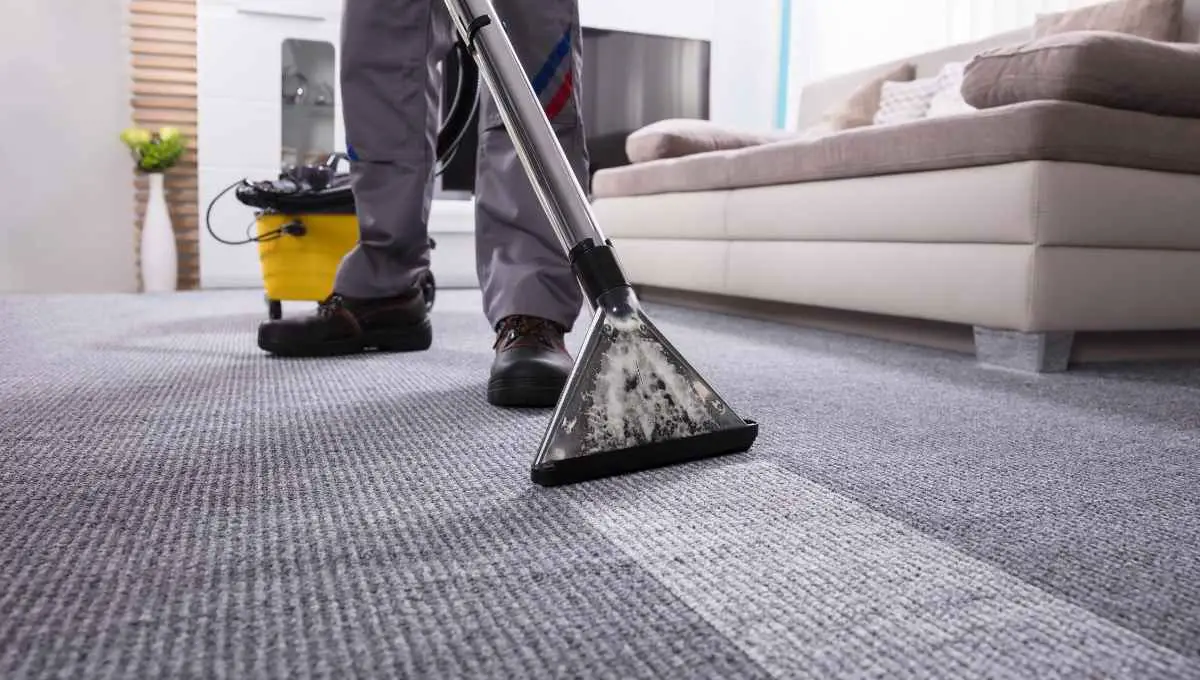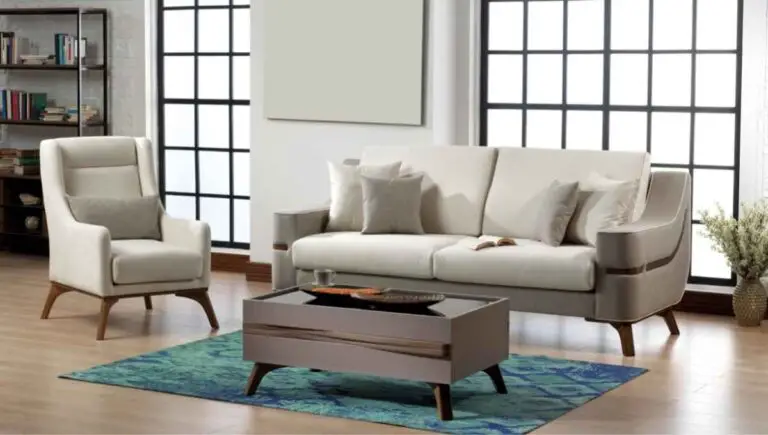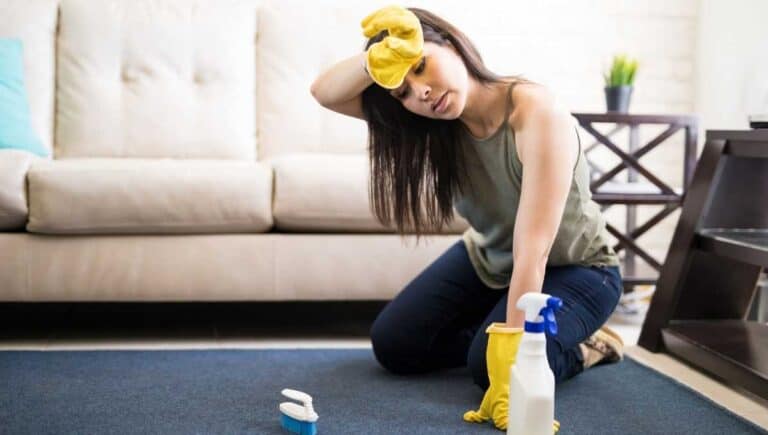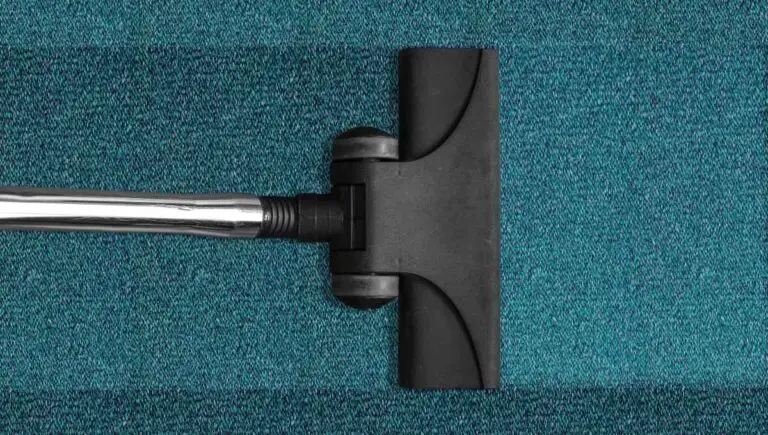Why Is My Carpet Wet in One Spot? (Do This to Fix It ASAP!)

Carpets can be a comfortable and cozy addition to any home, but when they start to show signs of water damage, it can be a cause for concern. If you have noticed a wet spot on your carpet, it’s important to determine the cause and take action to prevent further damage.
The cause of a wet spot on your carpet could be anything from a spill or leak to a plumbing issue. It’s important to identify the source of the water and take steps to address it as soon as possible to prevent mold growth and other potential problems.
In this blog post, we will explore the common causes of wet spots on carpets and provide tips on how to address the issue. Whether you’re dealing with a small spill or a major plumbing issue, it’s important to take action quickly to minimize damage and protect your home.
So, let’s dive in and find out what’s behind that wet spot on your carpet!
This post contains affiliate links. This means Household Blogger may earn a commission should you make a purchase using any of our links. Please refer to our full affiliate disclosure policy for full details.
Here’s a Quick Pro Tip!
A wet spot on your carpet should be dried as soon as possible. There are various ways to dry a carpet, some more effective than others. We have compiled the most recommended products to use when drying your carpet.
Our favorite products from Amazon to dry your carpet:
1. Dehumidifier – This is one of the best tools to dry your carpet as quickly as possible
2. Baking Soda – After drying most of the water, use baking soda to absorb the last moisture out of your carpet.
3. Stanley Wet/Dry Vacuum – Using a wet/dry vacuum would help you clean still-standing water on your carpet.
Source of Wet Carpet
When you notice a wet spot on your carpet, your first instinct is to investigate the source. Did someone spill liquid on the carpet, or does your house have another problem? Let’s look at what could cause a wet spot on your carpet.
Why Is My Carpet Wet Out of Nowhere?
You could have a foundation leak if your carpet is wet, seemingly out of nowhere. When water pools in and around your foundation due to faulty plumbing, it can seep the water through the foundation into your carpet.
It’s possible that rainwater does not drain away and eventually seeps into your foundation. In any case, you should have a plumber come check out your plumbing if you notice random wet spots on your carpet.
What Happens When Water Leaks on the Carpet?
When water leaks on a carpet, it can seep underneath the carpet and cause permanent damage. This will also become a potential breeding ground for mold and mildew. You should dry up the water on a carpet as soon as possible.
You can use fans, open windows, and dehumidifiers to dry a carpet, or you can use a carpet dryer. If the water leak is severe, you would need to lift your carpet and dry underneath it. You can get professionals to re-fit the carpet.
Why Are There Random Wet Spots on My Carpet?
A foundation leak is the most probable cause of unexplained wet spots on your carpet. This happens when the concrete underneath your house cracks and damages the waterlines built into the foundation.
A foundation leak can cause severe problems in your house, so you should try to get to the bottom of the issue as soon as possible. You should turn off the main water line when you see wet spots on your carpet.
Can Condensation Make a Carpet Wet?
Condensation can make your carpet wet in cold rooms, like a basement. When the humid air from outside meets the cool air from inside, it could form condensation on your carpet. However, it probably won’t be enough to make your carpet completely wet.
Condensation will probably only dampen a few spots on your carpet. If your carpet is completely wet, you might have a foundation problem. You should contact a plumber to check for any cracked or broken pipes in your foundation.
How Do I Find a Water Leak Under My Carpet?
Usually, a water leak will be around the same area where your carpet is wet. If the leak is in your foundation, you won’t be able to see it. A plumber would be able to test your water flow and determine where the water leak is.
So, if you notice inexplicable wet spots on your carpet, turn off the water supply and call a plumber. A water leak is not a problem that will fix itself, and besides increasing your water bill, it could also attract mold and mildew to grow underneath your carpet.
You might also enjoy our post on If You Can Vacuum a Wet Carpet
Fixes for a Wet Carpet
So after determining the source, you realize that now you need to dry (or replace) a wet carpet. In this section, we’ll look at the next necessary steps, if you should replace your carpet, and how thorough you should be.
Should a Wet Carpet Be Replaced?
It depends on the type of water that makes your carpet wet. Clean water from a water leak that is dried within 48 hours does not need to be replaced. However, contaminated water, like sewage or water from a flood, requires a carpet replacement.
The EPA suggests replacing carpets that are submerged in any water for an extended period of time. Contaminated water can pose extreme risks to your respiratory health, even when the carpet dries down.
Can You Vacuum Over a Wet Carpet?
You can vacuum over a wet carpet, but not with your normal vacuum cleaner. These are usually designed only for dry cleaning, not wet cleaning. Some vacuums, however, are designed to clean wet messes as well.
Vacuums like the Stanley Wet/Dry Vacuum and the Craftsman Wet/Dry Vacuum are designed to clean both dry and wet messes. You can use a wet/dry vac to vacuum over a wet carpet.
How Do You Fix Wet Carpets?
For small wet spots, you can dry up most of the water with a towel and sprinkle baking soda over the remaining moisture. Leave the baking soda on the spot for 1 hour, and then vacuum the baking soda. Your wet spot should be completely dry.
If your whole carpet is submerged in water, you would need a wet/dry vacuum cleaner. You could use a broom to sweep away most of the water, and then use a wet/dry vacuum cleaner to suck up the water.
How Long Can Carpet Stay Wet?
You should always try to dry a carpet as soon as possible. If a carpet is soaked with water for more than 48 hours, it would need to be replaced. The longer the carpet is wet, the more likely mold will start to grow.
If your carpet is wet for longer than 48 hours, you should contact professional carpet installers to remove your old carpet and clean your floor underneath. They will also install and fit a new carpet in your house.
Why Is My Carpeted Floor Sweating?
If your carpet is sweating, it is either condensation or a leak in your foundation. It could be condensation if your carpet is in a very cold room that comes into contact with hot, humid air.
If your carpet is sweating in your living room while the windows are open the whole day, it might be a foundation leak. Either way, you should call a plumber to have a look and give their professional opinion.
You might also enjoy our post on If You Can Put Furniture on Wet Carpet
Mold Issues in Wet Carpets
Everyone has experience with mold, and no one wants it in their house. Unsurprisingly, wet carpets can attract mold and mildew, so let’s dive into preventing mold growth in and underneath your carpet.
How Long Does It Take for Mold to Grow in Wet Carpets?
Mold can grow on and underneath wet carpets within 24 hours. That’s why it’s crucial to dry your carpet as soon as possible. If your carpet has been submerged in water for more than 48 hours, it should be replaced.
Mold in your carpet can be a serious health risk to the people living in the house, especially those suffering from respiratory illnesses like asthma. When you notice mold, you should have your carpet professionally cleaned or completely replaced.
Will Carpet Mold if It Gets Wet?
Mold can grow on a carpet if it stays wet for longer than a few hours. If you notice wet spots on your carpet, you should try to dry it up immediately, and keep an eye out for signs of mold.
Using baking soda is one of the easiest ways to dry wet spots on your carpet. Sprinkle baking soda over the wet spot and leave it for 1 hour. The baking soda will absorb the moisture from the carpet, after 1 hour you can vacuum the baking soda and have a clean, dry carpet.
How Do You Check for Mold Under a Wet Carpet?
The first sign you are likely to notice is a musty smell coming from your carpets. If your carpet has been wet recently and has since started to smell musty, it’s safe to assume that you have mold growing under your carpet.
Another clear sign is spots of black, white, or green discoloration on your carpet. If you notice a musty smell or discoloration in your carpet, you should get a professional cleaning company to assess your carpet and inspect it for mold.
Drying a Carpet
After determining the source of the wet spot, you now need to dry the carpet. There are many different methods to remove moisture from your carpet. Let’s look at what the best option could be for you.
Does Cold Air Dry Carpet?
Cold air can dry a carpet, but not as fast as hot and humid air. Humid air can evaporate the moisture in the carpet quicker, thus drying the carpet quicker. To dry your carpet the quickest, heat up the air coming into the room.
If you have no access to hot, humid air, you can use a dehumidifier in the same room as a wet carpet. It will absorb the moisture in the room and in the carpet. You should also open all windows and doors to improve air circulation in the room.
Does Baking Soda Dry Carpet?
Baking soda effectively absorbs moisture, so it can absorb the moisture from your carpet. However, this will not work if your carpet is soaked in still standing water, you would first need to dry up the water with a towel or wet/dry vacuum cleaner.
Once all the excess water is removed, and you only have a damp carpet left, it’s time to reach for the baking soda. Sprinkle a generous amount all over the wet spot and leave it to sit for 1 hour. Get your vacuum cleaner and clean up the baking soda, you should have a dry carpet underneath.
Should I Turn on a Heater to Dry Carpet?
You should turn on a heater to dry a carpet since warm air can hold more moisture than cold air. The carpet will dry quicker with a heater blowing over it, although it won’t happen within minutes.
If your carpet is wet and you want to use a heater to dry it, it would need to run for a couple of hours. Even when the carpet feels dry, there probably still is some moisture in the carpet. Run your heater for a few hours after the carpet feels dry to prevent mold from growing.
What Dries Carpet Faster?
A dehumidifier is one of the best ways to dry your carpet quickly. It removes the moisture from the air and your carpet, effectively speeding up the drying process. Just remember to clean the water tank very often.
For the shortest drying time, position a heater to blow over your carpet and use a heavy-duty dehumidifier to remove the moisture from the room. The drying time might still be a few hours, depending on how wet your carpet is.
Is It Better to Dry Carpet With Heat or a Fan?
Warm air is always favored for drying, so a heater would be the more useful option to dry a wet carpet. Hot air can absorb more moisture and thus dry your carpet a lot faster than a fan.
Drying your carpet as fast as possible should be a priority to avoid mold growing underneath your carpet. If you can’t dry your carpet within 24 hours, it’s best to seek the help of professional carpet cleaners t thoroughly clean and dry it.
You might also enjoy our post on If You Can Put a Carpet in the Washing Machine
Related Questions
How Do I Know if I Have a Foundation Leak?
If your carpets are wet with no explanation or if you hear running water underneath your floor, even though all the faucets in the house are shut. It’s always good to be on the lookout for signs of a foundation leak since it can cause a lot of damage.
Another symptom is smelling musty mold on the first level of your house or warm spots under your hardware floor. Keep an eye out for warped hardwood floors, which could also indicate a foundation leak.
Can Water Seep up Through the Foundation?
The foundation of most houses is made of concrete; most people don’t know that concrete is porous. When the moisture in the soil underneath your house increases, it pushes up into your foundation and eventually seeps through it into your house.
To solve water seeping through your foundation, you need to solve the drainage issue in the soil around your house. The first step is ensuring your yard is properly graded and slopes away from your house.
Why Is My Floor Wet With No Leak?
A wet floor with no leak could be caused by one of two things, a sweating floor, AKA condensation, or a foundation leak. A floor forms condensation when the air inside the room is cold and comes into contact with another room’s hot, humid air.
Concrete floors in a garage or basement are more likely to sweat. If your floor seems wet in a room that is not very cold and gets a lot of fresh air, it might be a foundation leak. If your carpets are wet, you should dry them as soon as possible.
Final Thoughts
Your carpet is wet in one spot due to a foundation leak. You need to dry your carpet as soon as possible but also find and fix the leak. Contact a plumber to look at your house’s plumbing lines and check for a water leak.









